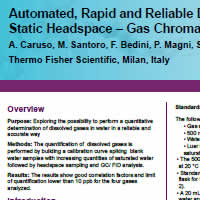Resumo do Pôster:
1. Introduction
Hydraulic fracturing or fracking is a technique that consists of pumping water into a wellbore to create small fractures into which fluids can migrate and be collected into the drilling well. Fracking facilitates the extraction of natural gas from shale plays in which it is unreachable with conventional technologies. The importance of this technique is increasing with the depletion of “traditional” gas fields offering the possibility to access a new energetic source. With the spreading of fracking, concern is raising about its safety and sustainability for the environment, in particular for air and water quality. Fracking processes can impact the quality of groundwater by leakage of gas, exposure to chemicals used during the drilling and mobilization of salts and metals from the subsurface.
For various chemicals, official methods, Standard Operating Procedure (SOP) and protocols do exist that offer guidelines for their analysis in water. However, there is not yet a formal method for the analysis of dissolved gas into ground or drinking water.
Different approaches are available for measuring the gas content in water. The most common method is that outlined by the industry standard SOP RSK-1751, which tests for dissolved gases via static headspace gas chromatography and then calculates results according to Henry’s Law, converting the concentration in the headspace into the partial pressure of the gas and using it to calculate the aqueous gas concentration. Another possible approach, adopted in this work, is to saturate water with a gas standard or a mix of gases and use that water to build a calibration curve via sequential dilution. This approach is currently being validated by the American Society for Test Methods (ASTM)2.
2. Purpose
To describe a rapid and reliable gas chromatography method for identifying and quantifying methane, ethane, ethylene, and propane in waters affected by hydraulic fracturing operations.
3. Method
The gas content in water was quantified by building a calibration curve obtained by spiking deionized water with increasing amounts of water previously saturated with those gases. The optimal saturation time has been calculated collecting samples every 30 minutes.
To avoid sample mishandling, the samples were collected in headspace-compatible vials (20 mL or 40 mL vials) without leaving headspace. To remove water samples without affecting the headspace, the water was carefully removed pushing nitrogen into the vial while water was withdrawn with the syringe, leaving 10 mL of sample into the vial for the headspace analysis. Samples were stored in refrigerator if not immediately analyzed. The headspace sampling has been performed with a valve-and-loop headspace autosampler. Some instrument parameters are presented in Table 1.
Table 1. Headspace autosampler and gas chromatograph conditions |
Temperatures |
Oven 70°C, manifold and transfer line 80°C |
Equilibration time |
15 min |
Vial Pressurization mode |
Pressure, set to 1.5 bar |
Loop Pressurization mode |
Pressure, set to 0.8 bar |
GC Oven |
Starting temperature 60 °C, to 200 °C at 20 °C/min, hold for 1 min |
Injector |
200 °C, carrier gas Helium 5 mL/min, split ratio 5:1 |
FID Detector |
250 °C, with default gas settings |
Column |
Thermo Scientific TracePLOT TG-BOND Q (25 m, 0.53 mm) |
4. Results and Discussion
Two calibration curves were built, for low-level and high-level concentration intervals, by adding aliquots of saturated water directly to 10 mL of DI water in 20 mL vials. The gas content of each calibration point was calculated from the solubility of the gases at 21 °C, the temperature at which the standards are prepared. The results of the calibration show good performance in terms of linearity with a R2 value above 0.99 for each one of the tested gases. A full elution of the target analyzed was obtained in less than six minutes. The vials containing standards could be refrigerated for up to 72 hours. This has been verified preparing and analyzing vials at different times after their collection.
5. Conclusion
The assessment of possible gas contamination of ground and drinking water can be performed following the methodology and approach presented in this work, by static headspace sampling and FID detection, following ASTM Work Item WK432672. The method developed is adequate for high-throughput laboratories in need of analyzing large quantities of water samples for their dissolved gases content.
6. References
- Sample Preparation and Calculations for Dissolved Gas Analysis in Water Samples Using a GC Headspace Equilibration Technique. U.S. Environmental Protection Agency Standard Operating Procedure, RSKSOP-175, Revision No. 2, May 2004.
- ASTM WK43267 - New Test Method for Measurement of Dissolved Gases Methane, Ethane, Ethylene, and Propane by Static Headspace Sampling and Flame Ionization Detection (GC/FID).
|

